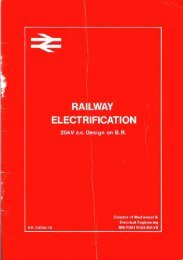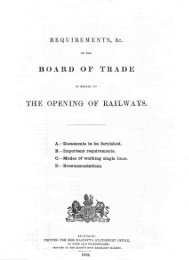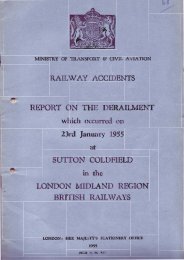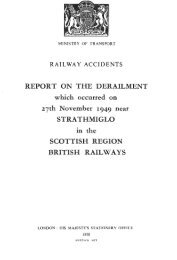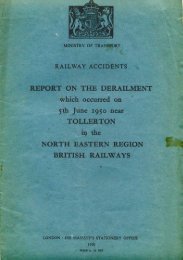R A I LT R AC K - The Railways Archive
R A I LT R AC K - The Railways Archive
R A I LT R AC K - The Railways Archive
Create successful ePaper yourself
Turn your PDF publications into a flip-book with our unique Google optimized e-Paper software.
freight<br />
Volume overall. . .<br />
grew by 12% last<br />
year and we expect<br />
a similar increase<br />
this year<br />
84<br />
7.1 7.2<br />
7.1 Progress in 1998<br />
In last year’s NMS, we challenged ourselves and our partners<br />
in the freight industry to increase rail in the freight market<br />
and freight in the rail market.Early results are encouraging.<br />
Volume overall,when measured in gross tonne-kilometres,<br />
grew by 12% last year and we expect a similar increase this<br />
year. Our customers have begun to introduce new<br />
locomotives and wagons,increase their share of traditional<br />
rail freight markets and develop new ones. Together we are<br />
developing new freight terminals and bringing disused<br />
facilities back into use .<br />
In addition, we welcome the recent publication of the<br />
Sustainable Distribution document by DETR.It contains a<br />
number of important developments which will help set the<br />
scene for the further growth of the rail industry.<br />
We are pleased to be part of this renaissance in rail<br />
freight.We have started to increase the loading gauge on<br />
certain key routes so that the industry can address more of<br />
the intermodal market.We have streamlined the processes<br />
for developing projects and are introducing new equipment<br />
to make it easier for our customers to introduce more<br />
innovative services.In the last year, more than 100<br />
certificates for freight equipment have been approved by our<br />
Rolling Stock Approvals Board,with the introduction of the<br />
Class 66 locomotive and the UK-built steel-coil wagon by<br />
English, Welsh & Scottish Railway (EWS),and the Class 57<br />
locomotive and new intermodal wagons by Freightliner being<br />
particular highlights.<br />
We have reduced the number of delays that we cause<br />
to freight trains by over 10% and have developed extra<br />
paths on the network whose departure, arrival and transit<br />
times more readily meet the market’s future requirements.<br />
We have become more flexible in meeting customers’<br />
requirements by modifying our timetabling procedures to<br />
allow them to run more trains at short notice. Over the past<br />
two years,the number of freight trains run on short-term<br />
schedules has risen by 50% and is now more than half of the<br />
total,with a particular increase in trains run at less than 48<br />
hours’notice.<br />
<strong>The</strong>se developments have been achieved largely within<br />
the current capacity and capability of the network.Spare<br />
capacity remains, for the time being,on most routes and we<br />
have identified a number of additional paths on key freight<br />
corridors.But,if our customers’market forecasts are to be<br />
achieved, we will need to continue to invest in the<br />
infrastructure in anticipation of market demand as well as<br />
seek timetabling solutions to accommodate growth in both<br />
passenger and freight traffic.<br />
However, in assessing the future, we must sound a note of<br />
caution.Some of the recent growth has been in traditional<br />
rail freight markets where the increase has been in distance<br />
rather than tonnage. Growth in the net tonnes car ried has<br />
been more modest.<strong>The</strong> rail industry has not yet made<br />
significant advances into the core road freight markets.And,<br />
together with other industry parties, we have more work to<br />
do in developing a mechanism to keep our track access<br />
charges affordable and above our avoidable costs,while<br />
simultaneously investing to meet the longer-term market<br />
requirements.<br />
7.2 Customer requirements<br />
Over the past six months, we have been working closely<br />
with our customers to develop the rail freight market.<br />
This work has included:<br />
• a joint understanding of the market potential. We have<br />
used our customers’ forecasts in this NMS to assess the<br />
potential demand for additional capacity and for<br />
improvements in capability of the network.<br />
• a review of the economics of carrying rail freight on the<br />
network today which we have shared with key<br />
stakeholders.<br />
• reviewing a wide range of operating and development<br />
issues.From this work, we have identified a number of<br />
areas where we can make further improvements and<br />
have agreed targets with our customers to measure our<br />
progress.<br />
Overall,our customers have formally identified 194<br />
requirements.We have agreed a way forward on 161.Of the<br />
outstanding issues, 14 will be covered by the standard<br />
industry processes, or by us providing further information to<br />
support our views, eg indicative timetables of future capacity<br />
on particular routes.We are developing plans for the<br />
remaining 19,having discussed them further with our<br />
customers and the Rail Regulator.We have referred to the<br />
key points in Table A opposite.



